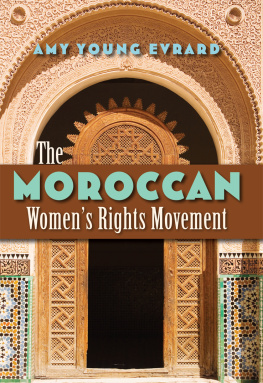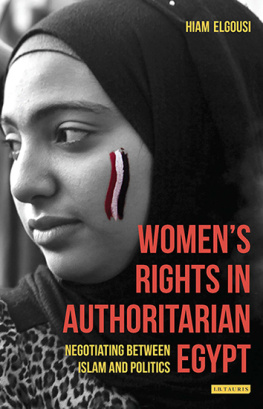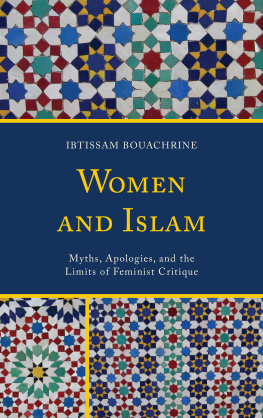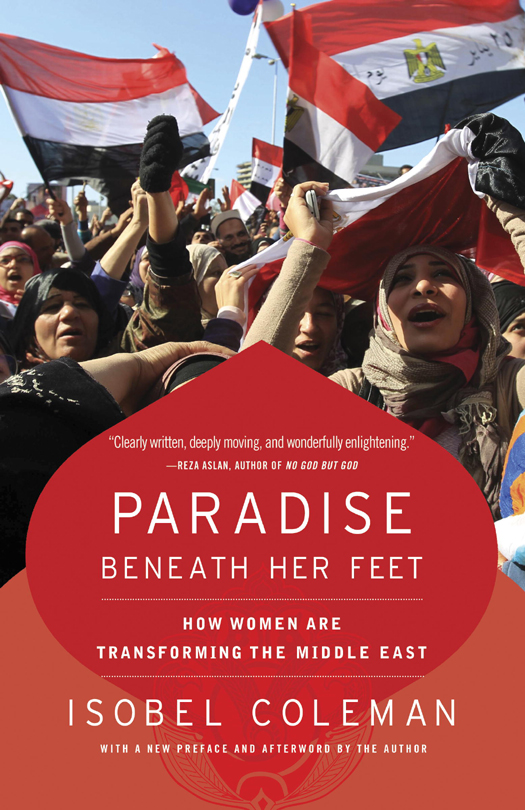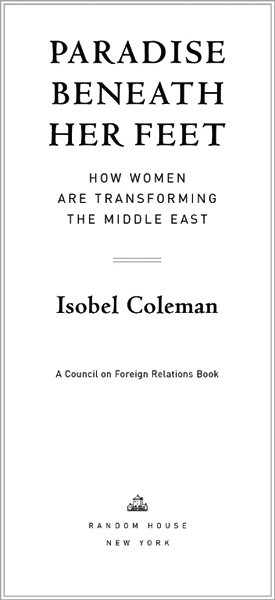For Cullen, Struan, Julian,
Josephine, and Adrienne
Jahmah said to the Holy Prophet, O Messenger of
Allah, I desire to go on a military expedition and I have come
to consult you. He asked him if he had a mother, and when he
replied that he had, he said, Stay with her because
Paradise lies beneath her feet.
A N -N ASAI , Muslim scholar (ca. 829915)
A mother is a school. Empower her, and you
empower a great nation.
H AFEZ I BRAHIM , Egyptian poet (18721932)
CONTENTS
Preface
Introduction
Map
PART I
1. Why Women Matter
The Payoff from Womens Rights
2. Gender Jihad
The Rise of Islamic Feminism
PART II
3. Revolutionary Sisters: Iran
4. Under the Crescent Moon: Pakistan
5. Redirecting Jihad: Afghanistan
6. Channeling Khadijah: Saudi Arabia
7. Daughters of Zainab: Iraq
8. Conclusion
Unveiling the Future
Afterword
Acknowledgments
Glossary
Notes
PREFACE
W hen I finished writing Paradise Beneath Her Feet in 2010, the Middle East was a profoundly different place than it is today. Just eight months after this books first publication, a simple Tunisian fruit vendor named Mohamed Bouazizi doused himself with paint thinner and set himself on fire to protest the confiscation of his vending cart. So began the revolutions that have rocked the region. On January 14, 2011, with millions of people demonstrating across Tunisia, President Zine el-Abidine Ben Ali capitulated, fleeing the country after twenty-three years of autocratic rule. A domino effect followed, with longtime dictators pushed from office by massive demonstrations and, in some cases, violent armed struggle. President Hosni Mubarak, who ruled Egypt for thirty years, stepped aside in February 2011; Muammar Gaddafi, Libyas brutal dictator for forty-one years, met a grisly death at the hands of rebels in October 2011. Ali Abdullah Saleh, Yemens dictator for thirty-four years, was forced out of office in early 2012. At the time of this writing, Bashar al-Assad clings to power in Syria as a growing civil war engulfs his country. The secular authoritarian regimes I describe in this book as surviving on life support have finally been swept away.
The new Middle East is still taking shape, but clearly the Arab uprisings have brought Islamismthe belief that Islam should instruct social, political, and legal affairs, not just ones personal lifeinto the political mainstream. Although the early instigators of Tunisias and Egypts protest movements counted many secularists, it is not at all surprising that the momentum of change has been captured by Islamists. Islamic organizations are better organized and better financed than liberal ones, and have well-established mosque-based networks through which they have long delivered social services to broad swaths of the population. Moreover, Islam is the cultural touchstone for most people, and polls consistently show large majorities across the Arab world support shariaIslamic lawas the basis of legislation. In Egypts first post-Mubarak parliamentary election, Islamists won more than 70 percent of the seats, and then in 2012, Muslim Brotherhood candidate Muhammad Mursi captured Egypts presidency. Islamists have also come to power through the ballot box in Tunisia and have gained greater influence in Yemen.
Islamists participation in politics has demonstrated that far from being monolithic, there is a broad spectrum of Islamist positions on such critical issues as freedom of speech, freedom of religion, and womens rights. For example, conservative Islamists would deny women most legal and family rights and believe that they should play little role in the public sphere. More progressive Islamists support broad rights for women and also encourage an active public roleincluding political leadershipfor women. This range of perspectives helps explain how, according to a 2012 Gallup poll, Arab women are as likely as men to favor sharia as a source of law. Many believe that Islam will in fact protect their rights.
In the midst of the ongoing Arab upheavals, the themes explored in this book are all the more relevant. As the political landscape of the Middle East is reconfigured, how effectively womens rights are incorporated into broader demands for social, economic, and political change is in many ways a bellwether for the future of the region. With the rise of long-suppressed religious parties, the need to reconcile demands for sharia with womens rights, and more broadly human rights, is already emerging as a fault line. The top-down, heavy-fisted approach of the regions discredited secular dictators, who simply pushed through legal changes that benefited women (in no small part to appear modern and to curry favor with Western benefactors) must now be replaced with a more inclusive, broad-based approach that will require the support, or at least the acquiescence, of moderate religious leaders and Islamist parties.
Many fear this is an impossible taskthat Islam and womens rights cannot be reconciled, that the Arab upheavals will spread theocracy. But this book describes how that reconciliation has been happening for years across the Islamic worldin a growing movement of Islamic feminism. Muslim women want to practice their faith, but not at the expense of their economic, political, and social rights. Increasingly, they look to their faith as a source of those rights.
The fact is that young Arab women today are more overtly religious than their mothers generation, but they are also significantly better educated, they are marrying later, having fewer children, and more likely to work outside the home. Their demands for greater freedom have been building for years. The uprisings have played a role in mobilizing these women, who since the earliest days of upheaval have been on the front lines of change. They have been protesting alongside men, blogging passionately and prolifically, covering the demonstrations as journalists and newscasters, launching social media campaigns, smuggling munitions, and caring for the wounded. And they have been taking to the streets in unprecedented numbers. One big demonstration in Cairos Tahrir Square at the end of 2011 was the largest demonstration of women in Egypt since 1919, when women mobilized under the leadership of feminist Hoda Shaarawi in anti-colonial demonstrations against the British. From Tunisia to Yemen, veiled and unveiled female protesters have become the iconic image of the Arab revolutions. When Tawakkul Karman of Yemen became the first Arab woman to win the Nobel Peace Prize, she acknowledged the millions of women across the region who have joined her in the fight for greater freedom.
The defiance of these brave activists has surprised many in the West who have long viewed Arab women only as oppressed victims of conservative patriarchy and religion. As this book argues, patriarchy and religious conservatism have conspired against women around the world and throughout the ages, and it runs particularly deep in the modern Middle East. But women are more determined than ever to change that reality, and given the strength of Islamism today, progressive interpretations of Islam will have to be part of the solution.
Change, however, is rarely easy, and Arab women are already finding it was easier to overthrow dictators than to attain greater gender equality. Their task today is made harder by that fact that for decades in the Middle East, the womens rights agenda was closely associated with the now-discredited authoritarian regimes: Egypts Suzanne Mubarak ran a state-affiliated womens NGO; Leila Ben Ali, Tunisias much-hated hairdresser-cum-First Lady, was president of the Arab Women Organization, an intergovernmental body sponsored by the Arab League; and both Syrias Asma al-Assad and Jordans Queen Rania have been closely identified with womens issues.




